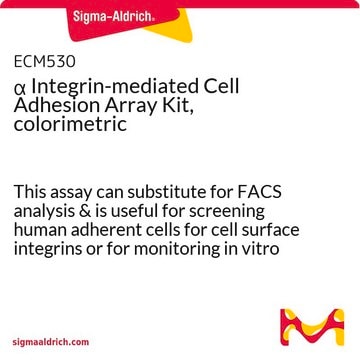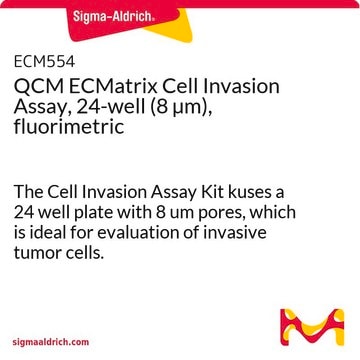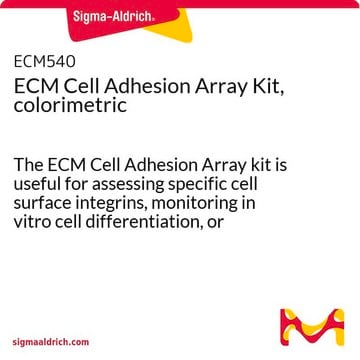ECM534
β Integrin-mediated Cell Adhesion Array Kit, fluorimetric
The Beta Integrin-Mediated Cell Adhesion Array Kit can be used for assessing the presence or absence of specific integrins on the cell surface.
Anmeldenzur Ansicht organisationsspezifischer und vertraglich vereinbarter Preise
Alle Fotos(1)
About This Item
UNSPSC-Code:
12352207
eCl@ss:
32161000
NACRES:
NA.32
Empfohlene Produkte
Qualitätsniveau
Speziesreaktivität
human
Hersteller/Markenname
Chemicon®
Methode(n)
cell based assay: suitable
NCBI-Hinterlegungsnummer
Nachweisverfahren
fluorometric
Versandbedingung
wet ice
Angaben zum Gen
human ... ITGB1(3688)
Anwendung
Research Category
Zellstruktur
Zellstruktur
The Beta Integrin-Mediated Cell Adhesion Array Kit can be used for assessing the presence or absence of specific integrins on the cell surface.
The CHEMICON® Beta Integrin-Mediated Cell Adhesion Array Kit can be used for assessing the presence or absence of specific integrins on the cell surface. This assay can substitute for FACS analysis (6) and is useful for screening human adherent cells for cell surface integrins or for monitoring in vitro cell differentiation or genetic modification of cells.
For Research Use Only. Not for use in diagnostic procedures.
For Research Use Only. Not for use in diagnostic procedures.
Verpackung
96 wells
Komponenten
Beta Integrin Array Plate: (PN: 90600) One 96-well plate with 12 strips. Each strip contains one well each of the mouse anti-beta integrin monoclonal antibodies: (beta1, beta2, beta3, beta4, beta6, alphaVbeta5, and alpha5beta1), and one goat anti-mouse negative well. See the plate layout on insert data sheet.
4X Cell Lysis Buffer: (Part No. 90130) One bottle - 16 mL
CyQuant GR Dye: (Part No. 90132) One vial - 75 μL
Assay Buffer: (Part No. 90601) One bottle - 100 mL
4X Cell Lysis Buffer: (Part No. 90130) One bottle - 16 mL
CyQuant GR Dye: (Part No. 90132) One vial - 75 μL
Assay Buffer: (Part No. 90601) One bottle - 100 mL
Lagerung und Haltbarkeit
The Beta Integrin Array Plate can be stored at 2° to 8°C in the foil pouch up to its expiration date. Unused strips may be placed back in the pouch for storage. Ensure that the desiccant remains in the pouch, and that the pouch is securely closed. Keep the remaining kit components at 2° to 8°C.
Precautions
No data is available on the biological toxicity of CyQuant GR™ dye. This reagent binds to nucleic acids, and as such, should be treated as a potential mutagen which may cause cancer and heritable genetic damage. Handle with caution. The DMSO stock solution should be handled with special caution as DMSO can facilitate the entry of organic molecules into tissues.
Precautions
No data is available on the biological toxicity of CyQuant GR™ dye. This reagent binds to nucleic acids, and as such, should be treated as a potential mutagen which may cause cancer and heritable genetic damage. Handle with caution. The DMSO stock solution should be handled with special caution as DMSO can facilitate the entry of organic molecules into tissues.
Rechtliche Hinweise
CHEMICON is a registered trademark of Merck KGaA, Darmstadt, Germany
GR is a trademark of Sigma-Aldrich Co. LLC
Haftungsausschluss
Unless otherwise stated in our catalog or other company documentation accompanying the product(s), our products are intended for research use only and are not to be used for any other purpose, which includes but is not limited to, unauthorized commercial uses, in vitro diagnostic uses, ex vivo or in vivo therapeutic uses or any type of consumption or application to humans or animals.
Signalwort
Danger
H-Sätze
Gefahreneinstufungen
Aquatic Acute 1 - Aquatic Chronic 2 - Eye Dam. 1
Lagerklassenschlüssel
10 - Combustible liquids
Analysenzertifikate (COA)
Suchen Sie nach Analysenzertifikate (COA), indem Sie die Lot-/Chargennummer des Produkts eingeben. Lot- und Chargennummern sind auf dem Produktetikett hinter den Wörtern ‘Lot’ oder ‘Batch’ (Lot oder Charge) zu finden.
Besitzen Sie dieses Produkt bereits?
In der Dokumentenbibliothek finden Sie die Dokumentation zu den Produkten, die Sie kürzlich erworben haben.
Matthias Rath et al.
Cellular and molecular life sciences : CMLS, 79(6), 340-340 (2022-06-07)
Cerebral cavernous malformations (CCM) are low-flow vascular lesions prone to cause severe hemorrhage-associated neurological complications. Pathogenic germline variants in CCM1, CCM2, or CCM3 can be identified in nearly 100% of CCM patients with a positive family history. In line with
Unser Team von Wissenschaftlern verfügt über Erfahrung in allen Forschungsbereichen einschließlich Life Science, Materialwissenschaften, chemischer Synthese, Chromatographie, Analytik und vielen mehr..
Setzen Sie sich mit dem technischen Dienst in Verbindung.









